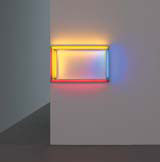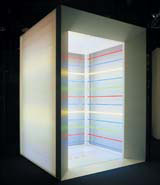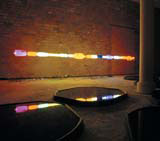Strip show
Minimalist artist Dan Flavin has the ability to transform a space dramatically using basic light fittings, which has made him an enduring influence among architects and interior designers, says Dominic Lutyens.

Minimalist artist Dan Flavin has the ability to transform a space dramatically using basic light fittings, which has made him an enduring influence among architects and interior designers, says Dominic Lutyens
Looking at the work of Minimalist artist Dan Flavin – soon to go on show at London’s Hayward Gallery – from the context of interior design might appear to trivialise it, but it has sanction from none other than Flavin himself. Early in his career, New York-born Flavin (1933-1996) moved from making small-scale light pieces to large, site-specific installations in radiant colours that interacted with architectural features – from door frames to stairwells – or subdivided space by forming mammoth barriers.
Critics have tended to interpret his work as mystic or symbolic, making connections to art historical traditions as haloes or Michelangelo Caravaggio’s chiaroscuro. Yet Flavin refuted these readings and aimed to demystify art. ‘I believe art is shedding its vaunted mystery for a sense of decoration,’ he said, while consistently using fluorescent strips bought from hardware shops.
From the mid-1960s onwards, his light installations, in shades ranging from sulphurous yellow to blushing pink, helped dissolve the boundaries between art, architecture and design. Flavin described his work as combining ‘traditions of painting and sculpture in architecture with electric light defining

space’. Perhaps the apotheosis was his illumination of the entire spiral gallery of New York’s Guggenheim Museum in 1992.
If this mindset was once radical, today it is increasingly common for artists, architects and lighting designers to integrate lighting effects extensively into buildings, and many cite Flavin as an influence. His unvarnished light fittings have also influenced mainstream lighting/ light sabre-like ambient lamps can be found at Habitat and Ryness. ‘Minimalist’ might be too imprecise a label for Flavin, but, says Tiffany Bell, curator of the Hayward show, he shares with fellow Minimalists Donald Judd and Carl André a tendency to ‘use industrial materials, serial composition and incorporation of real space as part of their art’.
It’s the latter quality that Flavin now shares with many designers, for instance, Speirs and Major. ‘We’ve been influenced by Flavin – we’ve not been embarrassed to use raw light bulbs. In our office we’ve got a ladder made of lights. Our interiors for Point Hotel in Edinburgh are similar to Flavin’s installation at the Hauserman showroom in Los Angeles from 1982 to 1984,’ says partner Mark Major. ‘What appeals about Flavin is that he changes your perception of physical space simply by using intangible light. And whereas [light artist] James Turrell disguises his light sources, Flavin allows you to see his, which makes his work more immediate,’ he adds.
Flavin-esque strip lights are also in evidence in architect Wilkinson Eyre’s Centre for Lifelong Learning, at London’s City and Islington College, where artists Vong Phaophanit and Claire Oboussier have threaded coloured neon pipework throughout. And framing windows at the recently refurbished Breast Care Centre at London hospital Barts (with interiors by architect Greenhill Jenner) are Flavin-like pieces by artist David Batchelor.

Young architect Henning Stummel, meanwhile, has created an extension for a London Georgian home whose oak cladding incorporates illuminated horizontal Perspex boards which recall Flavin’s strip lights.
Flavin’s ravishing lightshows aside, many designers admire the fact that his industrial lights have helped legitimise the use of humdrum fittings in art and design. Architect, installation artist and Flavin fan Francesco Draisci – whose installation, Intencity, at Designers Block in 2001, comprised a stunning polychrome garland of plastic detergent bottles lit from within – is known for his atmospheric use of lighting (including fluorescent bulbs). ‘What I find inspirational about Flavin is the fact that he made raw, industrial fittings acceptable and used them in a poetic way,’ he says.
Dan Flavin: A Retrospective runs from 19 January to 2 April at the Hayward Gallery, South Bank Centre, Belvedere Road, London SE1 Tel: 020 7921 0813
-
Post a comment



